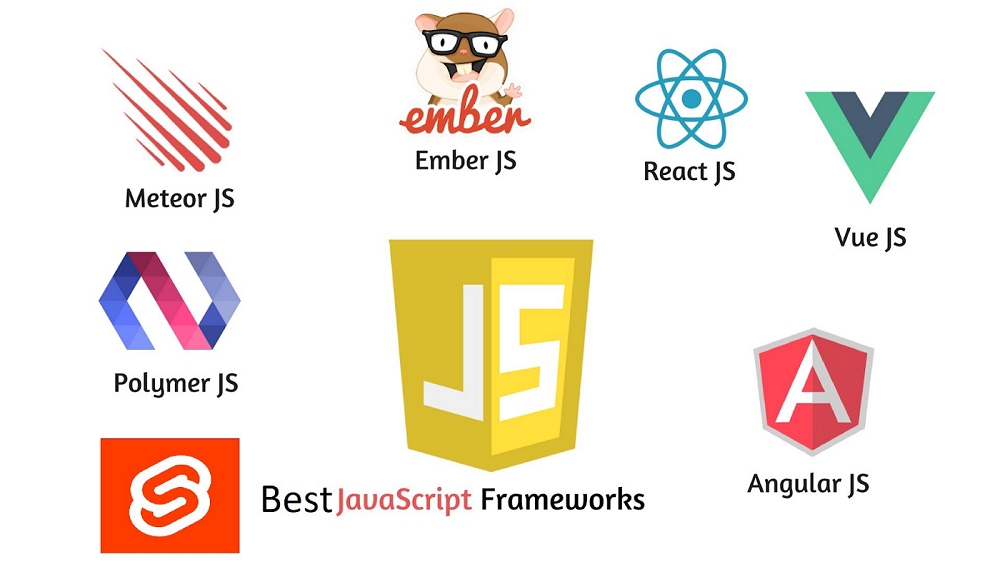What are JavaScript Frameworks? and Why Use One?

Software frameworks are an abstraction that allows users to customize software that provides general functionality by writing extra code. For example, we can describe the JavaScript framework as an application programming framework in JavaScript, allowing programmers to alter the functions and then use them to their advantage.
Moreover, Frameworks can be more adaptable to design websites, which is why most website developers favor these frameworks. Additionally, JavaScript frameworks are software that can make working using JavaScript simpler together with more fluid. Therefore, they can also allow the developer to write the application to be device-responsive. This flexibility is another reason. Furthermore, JavaScript frameworks are prevalent in using high-level machine language. Moreover, Let’s review the top JavaScript Frameworks for 2021.
5 Top JavaScript Frameworks
Angular
A very efficient, robust, together with free-of-cost JavaScript framework is available in Angular. Additionally, Google runs this framework and is designed to create a Single Page Application (SPA). Therefore, It incorporates HTML into the app and then interprets attributes to carry out data binding.
Features
Cross-Platform
- Progressive Web Apps
- Native
- Desktop.
Speed and Performance
- Code Generation
- Universal
- Code Splitting
Productivity
- Templates
- Angular CLI
- IDEs
Full Development Story
- Testing
- Animation
- Accessibility
React
Facebook developed the framework, and Facebook React was acquired by Facebook. Therefore, The React framework has gained popularity in a short time. Additionally, It’s used to create and run in the context of a dynamic User Interface of websites with significant incoming traffic. Furthermore, it allows the use of virtual DOM, which means that integrating it with other applications is more straightforward.
Features
- Declarative
- Virtual DOM
- Event handling
- JSX
- Performance
- React Native
- Component-Based
Vue.js
Although it was developed in 2016, the JavaScript Framework has entered the market and proved its value by providing various options. For example, dual integration is among the most appealing features to create high-end SPA (Single Page Applications. In addition, it’s a more trusted platform for developing cross-platform applications.
Features
- Virtual DOM
- Data Binding
- CSS Transitions and Animations
- Template
- Methods
- Complexity
Ember.js
Ember.js’ introduction to Ember.js to the software market was in 2015, and since its introduction, Therefore, it has gained recognition due to its broad range of applications. Additionally, The capabilities of Ember.js allow two-way data binding. This helps provide a solid platform to handle complex user interfaces. Furthermore, Many popular websites such as LinkedIn, Netflix, Nordstrom, and many more utilize the Ember.JS platform to host their websites.
- The creation of a usable and easy-to-manage JavaScript web-based application.
- It is a web application that provides HTML and CSS as part of the development model at its basis.
- Provides instance initializers.
- Ember.js provides routes that form the basis of tools used to manage your URL.
- HTML0 Ember.js offers Ember Inspector, an Ember Inspector tool for debugging Ember applications.
- Ember.js employs templates that allow you to update models whenever the application’s content is changed instantly.
Meteor
Meteor’s application space (aka Meteor.js, also known as MeteorJS) has its name since its diversity covers an almost significant section of software development. Therefore, The framework’s uses encompass essential areas such as back-end development, managing data, managing business processes, and rendering of the frontend.
- Full-Stack Solution
- Development Ecosystem
- Isomorphic JavaScript Code
- Frontend Solution
- Database Integration
Node.js
Node.js is an application that runs on servers. JavaScript run-time application that is compatible with all platforms and is open-source. Additionally, It is capable of controlling Asynchronous I/O through its event-driven design. Therefore, It operates within JavaScript Runtime. JavaScript Runtime environment and shows the similar characteristics of JAVA such as packaging, threading, and creating loops.
Features
- It is swift
- I/O can be described as event-driven and asynchronous:
- Single-threaded
- Highly scalable:
- No buffering
- Open source
- License
Polymer
Polymer is an open-source JavaScript library developed by Google that can be used to create the elements of a website without going into a more complex scale. Additionally, it can support both one-way and two-way data binding, thus allowing for a broader application space.
Features
- Polymer.js is a JavaScript library that is built using web-standard APIs. It provides the easiest way to construct customized HTML elements.
- Polymer.js provides the polypills that allow you to design custom and reused components.
- It is used to facilitate the creation of widgets that can be reused in websites and applications.
- HTML0It uses Google Material Design to create mobile applications that allow for quick and simple development of mobile apps.
- The customized elements are distributed throughout the Internet and permit users to access these elements by using HTML Imports.
Aurelia
Aurelia Framework is the most current version of JavaScript that can build any interface. Therefore, It’s the next version of the framework to create more robust web pages. Additionally, Aurelia’s framework Aurelia can extend HTML to meet various needs and uses data binding. Furthermore, its contemporary structure ensures that the primary purpose of toll is to interpret between server and client simultaneously.
Features
- Components
- Web Standards
- Extensible
- Commercial Support
- License
Backbone.js
It is among the most well-known JavaScript frameworks. It is simple to understand and master. Therefore, it is a great tool to develop Single Page Applications. Additionally, The creation of this framework relies on the notion that all server-side functions have to be connected via an API, allowing you to create complex tasks by writing smaller amounts of code.
Features
- BackboneJS utilizes JavaScript functions, which makes the development of applications and the frontend a lot easier.
- Building blocks like model’s views, views, events collections, and routers create client-side web applications.
- This is an essential library that assists in the separation of the logic of user interface and business.
- It’s a free and open-source library. It has over 100 available extensions.
- It serves as a foundation for every project and aids in the structure of the program.
- BackboneJS has an implicit dependency on jQuery and a strong dependence on Underscore.js.
- It lets us create web-based client-side applications or mobile apps in a structured and well-organized structure and format.
Conclusion
In developing websites, JavaScript remains the predominant language, and consequently, Additionally, there are a variety of top JavaScript frameworks to pick from. However, We hope that our recommended list of frameworks that support JavaScript will help you select the most suitable one for your application. Furthermore, Consider carefully analyzing your requirements for your project before choosing the framework you will use to build your application. Therefore, Each framework has its distinct features that you might require in the development process. In addition to the elements, consider how you learn, the complexity of the documentation for compatibility, and community support. Moreover, If you’re seeking to understand JavaScript deep, The Complete JavaScript Course could be an excellent starting point that you can take.




